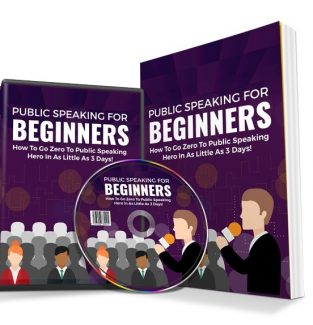
 License Type: Private Label Rights
License Type: Private Label Rights  File Type: ZIP
File Type: ZIP
 SKU: 62316
SKU: 62316  Shipping: Online Download
Shipping: Online Download
Sample Content Preview
Public Speaking Beginners
Day 1
Speaking in front of people, large crowds in particular, is usually perceived as the most stressful experience imaginable. The following ideas in this course are designed to help you, or anyone for that matter, convey your ideas and messages to either one person, or a large group in just about any setting. Creating an effective presentation, can seem very overwhelming. But here are strategies you can use to come up with an effective and powerful speech in 30 minutes or less, regardless of your target audience.
#1 Identifying your purpose
The importance of goal-setting must not be overlooked when preparing for any presentation. The very first thing you need do before you even embark on your presentation is to define your objectives. It is crucial that you begin with the end in mind. Ask yourself this, “What do I want to achieve from my speech?”, “What do I want my audience to receive?”, “What do I want my audience to do next?”
The first thing you need to do in the speech preparation process is to identify your purpose. The purpose of your presentation can range from creating awareness, fostering understanding, generating impact, selling a product, or even to inspire your audience. Remember that the main reason why you’re presenting in the first place is to give, not just gain. As such, your goals should be aligned with allowing your audience to benefit from your presentation. Your purpose-setting must be extremely clear, not just to yourself, but to your audience as well. This helps them internally craft the benefits they will gain from listening to you.
The biggest mistake of public speaking is when you start with the wrong purpose in mind. Mediocre speakers operate without a specific purpose which can easily cause stress and anxiety. The nature of your purpose is just as important as the purpose itself. Many speakers often mistakenly assume or even subconsciously decide that their purpose is audience validation and approval. Wrong. This is completely foolish. This causes great pressure on the speaker to be absolutely perfect in order to win unanimous approval and this causes a great deal of anxiety. I call this a “stress-producing” purpose.
Once you’ve established the purpose of your presentation, you can easily craft your presentation around it in order for it to be achieved. Remember that the essence of public speaking is not to GAIN something, but to GIVE something. When you operate with that frame of mind, you automatically tune your body language, tone of voice and craft content that is useful for your audience. With that, you immediately attract the attention of the majority. To conclude this section, here’s a quick summary. Before even writing your speech, you need to clearly define your objectives and ask yourself, “What do you want to achieve with this?” and to set goals that benefit not just yourself, but your audience as well. Now that you’ve identified the purpose of your speech, you can move on to the next stage.
#2 Preparing your speech
Now that you’ve identified the purpose of your speech, it’s time you craft it. But before you do, it’s important to clarify your topic. One way to make sure you’ve got it all cleared up is to try out the “business card test” - can you state your main idea on only one side of a business card? If you can, you’re ready to move on. If you can’t, keep working on it until you can.
Now, you can start drafting your speech. Grab a sheet of paper and right at the top of the page, clearly state your desired topic and the goal of your presentation. Then move on to write your opening lines and follow that up with 4- 5 key points. Back these points up and summarize them in the conclusion. This is your outline. Now that you’ve listed your most important subjects, you can begin crafting your presentation based on the completed outline.
Before you start writing that speech out proper, let’s take a quick detour, and visit one of the greatest and most notable speeches made in human history - yes, Martin Luther King, Jr.’s “I Have A Dream”. Did you know that the most important, most often-quoted and the most powerful part of his entire speech, his iconic “I have a dream” statement, was made only in the last quarter of his entire powerful presentation? It makes you wonder how he managed to capture the full attention of over 200, 000 agitated, and angry civil rights supporters? If you were thinking that it was his authority, you’re wrong. And it wasn’t his looks either. Reverend King had a powerful introduction. He started with this, “Five score years ago, a great American, in whose symbolic shadow we stand today, signed the Emancipation Proclamation. This momentous decree came as a great beacon light of hope to millions of Negro slaves who had been seared in the flames of withering injustice. It came as a joyous daybreak to end the long night of their captivity.”
Martin Luther King, Jr. started his powerful speech with a strong, passionate story which set the mood for the rest of his speech. When you begin crafting your speech, you have to remember that the most important part is your introduction. If your audience’s attention is not captured within the first 30 seconds, you’re pretty much history. Your introduction can make, or break, your entire speech. Remember that a strong opening is King, pun unintended. You may start with a probing question, a strong statement, a personal story or even a quote. These elements not only set the mood for your speech, but also pique your audience’s attention and focus sufficiently to hook them for the rest of what you have to say.
Now that you’ve crafted a powerful introduction, you can move on to the core points of your speech. Each of these points should be backed by interesting stories, illustrations, historical references, humorous anecdotes, and examples that the audience may be able to relate to. Common stories or illustrations include references to common childhood occurrences, growing up pains or even teenage experiences. You can use these stories and examples to further reinforce your point. Humans are sensory creatures. If you’re able to pique more than just one sense - their hearing - you’ve got them hooked, forever.
Remember to include descriptives in your stories and even images for the visual ones in your audience. Analogies help your audience connect the dots of your points in their heads. Also remember to open and close each point with a clear transition. This makes it easier for your audience to follow your story. For those of you who’re selling to or motivating your audience, you may even address your audience’s pain, stress on the benefits of taking immediate actions, suggest a recommended course of action followed by closing remarks.
Now that you’ve detailed all the main points of your speech, you can start to write your close. A common, but effective, conclusion is a summary. This can be followed by an appeal or a call to action to challenge your audience, which is completely dependent on your purpose and topic. Run a quick summary by your audience and if necessary, outline clear guidelines and next actions they can take with the information you’ve just given them so that they do not feel like they’ve left your speech with nothing concrete to take with them.







